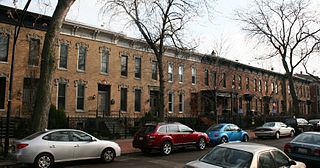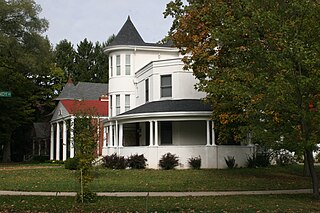DeKoven Street is a street in Chicago. Located in the city's Near West Side, it was named for John DeKoven, one of the founders of the Northern Trust Company.

The Bryn Mawr Apartment Hotel is a 12-story building in the Bryn Mawr Historic District in far-north neighborhood community of Edgewater in Chicago, Illinois. Located on North Kenmore Avenue, it is across the road from the Belle Shore Apartment Hotel. It was designated a historic Chicago Landmark by the Chicago City Council on November 6, 2002.

The Chicago Defender Building, located at 3435 S. Indiana Avenue in the Black Metropolis-Bronzeville District of the Douglas community area of Chicago, Illinois, housed the Chicago Defender from 1920 until 1960. Designed by Henry L. Newhouse, it was originally a synagogue. The building was designated a Chicago Landmark on September 9, 1998.

The Harris and Selwyn Theaters are twin theatres located in the Loop community area of Chicago, Illinois. They were built by Sam H. Harris and Archie and Edgar Selwyn. They were designated a Chicago Landmark on March 31, 1983. They have been redesigned by the Goodman Theatre, which is located in them.

The Kenwood District is a historic district in the officially designated Kenwood community area of Chicago, Illinois bounded by E. 47th and E. 51st Streets, S. Blackstone and S. Drexel Avenues. It was designated a Chicago Landmark on June 29, 1979. The official community areas were defined in the early 20th century and the current meaning of the Hyde Park neighborhood includes the area between 47th Street and 51st Street as a part of Hyde Park, although this area is officially the south half of the official Kenwood neighborhood. The region is part of the Hyde Park-Kenwood Historic District.

The Heald Square Monument is a bronze sculpture group by Lorado Taft in Heald Square, Chicago, Illinois. It depicts General George Washington and the two principal financiers of the American Revolution: Robert Morris and Haym Salomon. Following Taft's 1936 death, the sculpture was completed by his associates Leonard Crunelle, Nellie Walker and Fred Torrey.

Woman's Athletic Club is a historic building located along the Magnificent Mile in the Near North Side community area of Chicago, Illinois. Founded in 1898, it is the home of the first athletic club for women in the United States. It was named a Chicago Landmark on October 2, 1991.

The Wingert House is a nineteenth-century farmhouse located at 6231 North Canfield Avenue in Chicago, Illinois. One of the oldest surviving farmhouses within the Chicago city limits, the building received Chicago Landmark status on July 31, 1990. It is part of the Norwood Park neighborhood.

The Arlington and Roslyn Place District is a historic district in Chicago, Illinois, United States. The district was built between 1894 and 1910 by various architects. It was designated a Chicago Landmark on November 15, 1989.

The Burling Row House District is a historic district in Chicago, Illinois, United States. The district was built in the post-Chicago Fire year of 1875 by Edward J. Burling. It was designated a Chicago Landmark on November 15, 2000.
The Calumet/Giles Prairie District is a historic district in the South Side, Chicago community area of Chicago, Illinois, United States. The district was built between 1870 and 1910 by various architects. It was designated a Chicago Landmark on July 13, 1988.

The Hawthorne Place District is a historic district in Chicago, Illinois, United States. The district was built in the 1890s by various architects including the McConnell brothers, Burnham & Root, and Pond & Pond. It was designated a Chicago Landmark on March 26, 1996.

Old Edgebrook is a historic district and neighborhood in the Forest Glen community area of Chicago, Illinois, United States.

The William and Jessie M. Adams House is a Prairie school style house located at 9326 South Pleasant Avenue in Chicago, Illinois.

The Beeson House and Coach House is a Queen Anne style house located at 5810 West Midway Park in Chicago, Illinois, United States. The house was built in 1892 by Fredrick R. Schock for Fredrick Beeson. It was designated a Chicago Landmark on January 20, 1999.

The DuPont–Whitehouse House is an Italianate-style house located at 3558 South Artesian Avenue in the McKinley Park neighborhood of Chicago, Illinois, United States. The house was built between 1875 and 1876 by Oscar Cobb & Co. It was designated a Chicago Landmark on April 16, 1996.
The Eliel House is a house at 4122 South Ellis Avenue in Chicago, Illinois, United States. The house was built in 1886 by Adler & Sullivan for Mathilde Eliel. It was designated a Chicago Landmark on October 2, 1991.

The Four Houses by Architect Frederick Schock are Queen Anne and Shingle styles houses located at 5749 & 5804 West Race Avenue and 5804 & 5810 West Midway Park in the Austin neighborhood of Chicago, Illinois, United States. The houses were built between 1886 and 1892 by Frederick R. Schock. They were designated Chicago Landmarks on January 20, 1999.

The Soldiers' Home is an historic Italianate style building in Chicago, Illinois, United States. Located at 739 E. 35th Street, the Home was built in a series of phases from 1864 to 1923, designed by William W. Boyington and other architects. It was designated a Chicago Landmark on April 16, 1996. The Soldiers' Home is the last surviving building in Chicago with direct association to the American Civil War: during the war, the oldest part of the home was built to serve as a hospital for injured soldiers and after the war, it became a home for disabled and aged Union Army Veterans.

The Edward C. Waller Apartments are located from 2840 to 2858 W. Walnut Street in Chicago, Illinois. They were designed by Frank Lloyd Wright and built in 1895 and named after Edward C. Waller, a prominent Chicago developer after the 1871 fire. Waller and Wright collaborated on the Waller apartments and the Francisco Terrace apartments to execute Waller's pioneering idea of subsidizing lower income housing. Each apartment was designed with a parlor, chamber (bedroom), dining room, kitchen, bathroom, and closets.


















